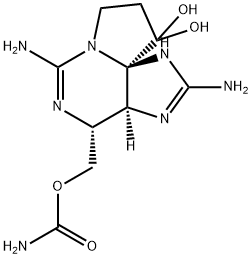First recognized in 1957 by Shantz et al. in the butter clam
Saxidomus giganteus, saxitoxin is a naturally occurring toxin that
is synthesized by various marine dinoflagellates and cyanobacteria.
It is used in neurochemical and molecular biology
research, but regulatory concerns have focused on its weaponization
and potent toxicological effects on animals and
humans. Saxitoxin causes paralytic shellfish poisoning (PSP) in
humans and other animals; whales having ingested organisms
contaminated with the toxin have died just hours after exposure.
In humans, PSP can occur as a result of consuming
shellfish or other seafood in which saxitoxin has accumulated.
While effects have been documented worldwide, the sources of
contaminated seafood have been identified as primarily the
west and east coasts of the United States.
To date, more than 30 different saxitoxin analogs have been
identified. These include pure saxitoxin (STX), neosaxitoxin
(neoSTX), the gonyautoxins (GTX), and decarbamoylsaxitoxin
(dc-STX); of these, STX, 6NeoSTX, GTX1, and dc-STX seem to
be the most toxic. The term saxitoxin typically refers to this
collection of compounds produced naturally by cyanobacteria.
Saxitoxin is far more potent than the classic puffer fish toxin
tetrodotoxin, and is one of only two naturally occurring
Schedule 1 chemical warfare agents (the other is ricin). In 1970,
President Nixon ordered stocks of the toxin destroyed in
compliance with U.N. agreements on biological weapons;
however, the Central Intelligence Agency revealed in 1975
that there was a remaining supply, which was distributed to research facilities by the National Institutes of Health in order
to study neurological diseases.
Crystalline solid; soluble in water and me thanol; forms dihydrochloride with HCl.
Saxitoxin is an alkaloid of nonplant origin.It is the neurotoxic constituent of dinoflagel lates (Gonyaulax catenella and G. excavata)the so-called “red tide” found along the U.S.coast. Shellfish, clams, and scallops consumethis and become extremely poisonous forhuman consumption.
Mussel poison; clam poison; paralytic shellfish poison; gonyaulax toxin. These poisonous shellfish have been connected to instances of toxic”red-tides” where the high concentration of algae discoloring the water were of the Gonyaulax genus.
Used as a too
As a Schedule 1 controlled substance under the Chemical
Weapons Convention of 1993, the use of saxitoxin is extremely
limited outside of weaponized forms. Its use as a chemical
reagent in research is its other important use, as it has been
instrumental in experiments to elucidate the mechanisms
involved in sodium channels used in cellular communication.
ChEBI: An alkaloid isolated from the marine dinoflagellates and cyanobacteria that causes paralytic shellfish poisoning.
Saxitoxin is an extremely toxic substance.It binds to sodium channels and the blocksnerve membrane. In humans, ingestion ofthis compound can produce tingling andburning in the lip, tongue, face, and thewhole body within an hour. This is fol lowed by numbness, muscular incoordina tion, confusion, headache, and respiratoryfailure. Death may occur within 12 hours.
LD50 value intraperitoneal (mice): 0.005mg/kg
LD50 value oral (mice): 0.26 mg/kg
Intravenous administration of 1 mL of1:2000 solution of prostigmine methylsulfatehas been reported to be effective againstsaxitoxin poisoning (Hodgson et al. 1988).
Dinoflagellates (flagellate protists, plankton) are primarily
responsible for the biosynthesis of saxitoxin, and bioaccumulation
tends to occur in several shellfish such as
mussels, clams, scallops, and cockles. Broth made from shellfish
can harbor saxitoxin as well due to its stability at normal
cooking temperatures. Consumption of the shellfish leads to
toxicity in humans, while consumption of other organisms in
which saxitoxin has accumulated (up the food chain, for
example) has historically affected other animals such as whales.
Data describing the environmental fate of saxitoxin is
extremely limited. There have been some studies investigating
the absorption/desorption capacities of various soils for the
compound, but more exhaustive studies are yet to be
reported.
Saxitoxin interrupts nerve transmissions by binding to voltagegated
sodium channels. Positively charged guanidinium
groups of saxitoxin interact with negatively charged carboxyl
groups at a site on the sodium channel (in a one-to-one ratio)
of neurons and muscle cells, resulting in blocked action
potentials and interrupted transmissions. The inactivation of
vasomotor nerves along with vascular smooth-muscle relaxation
follows and hypotension can additionally occur. When
muscles in the respiratory or cardiovascular system are affected,
death can result.
Intraperitoneal inoculation with STX extract in the freshwater
fish Hoplias malabaricus resulted in a variety of systemic
effects culminating in oxidative stress observed in the brain,
leading to lipid, protein, and DNA damage. Although the
exposure in this study was subchronic, apoptotic cellular
processes were implicated.
Schantz et al., J. Arner. Chern. Soc., 97, 1238 (1975)
